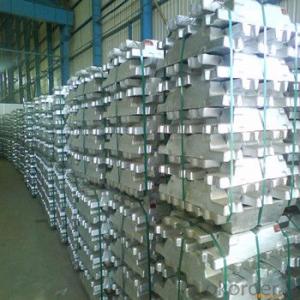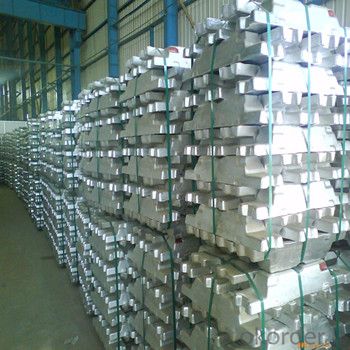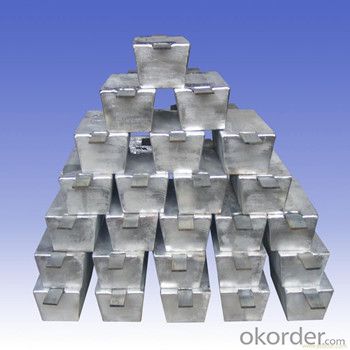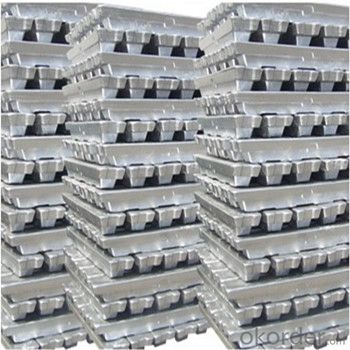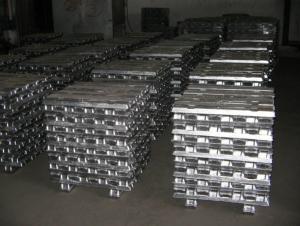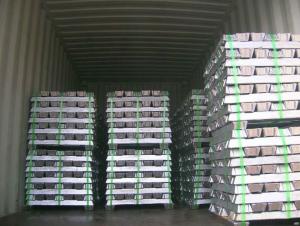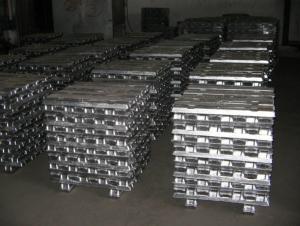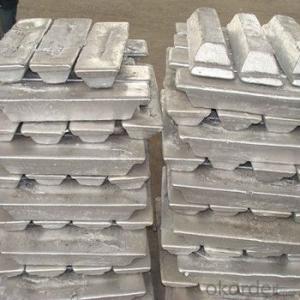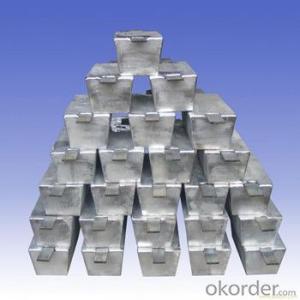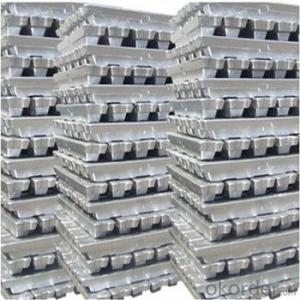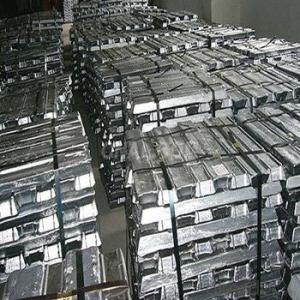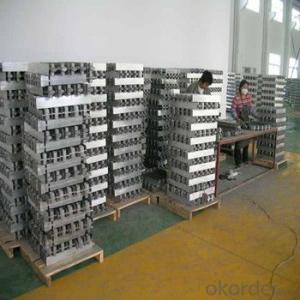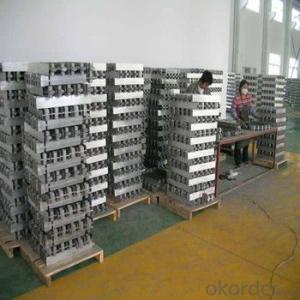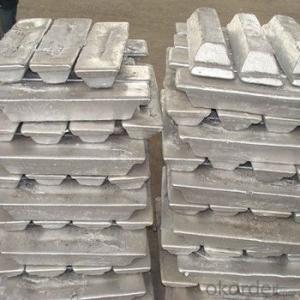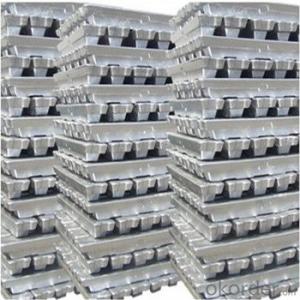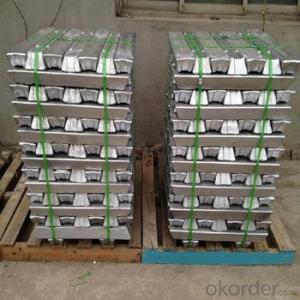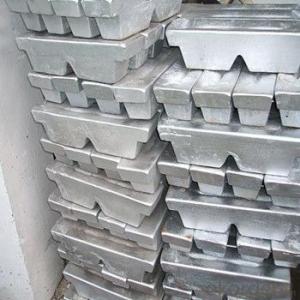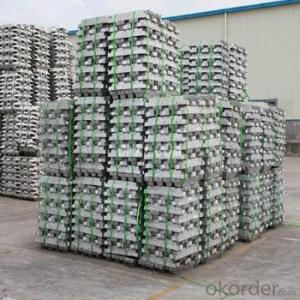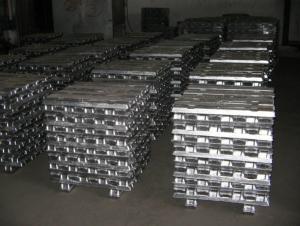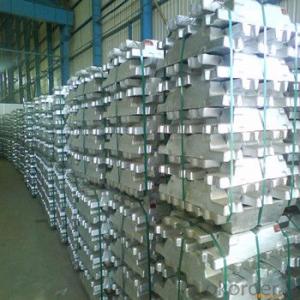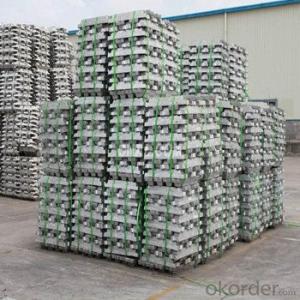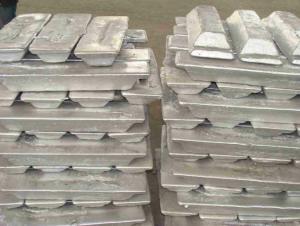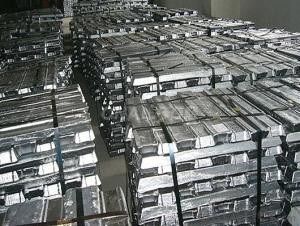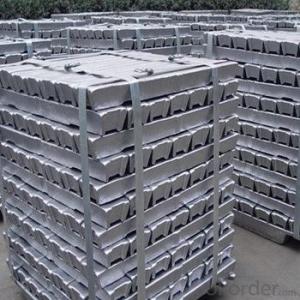Aluminum Pig/Ingot With Best Price From China
- Loading Port:
- China main port
- Payment Terms:
- TT OR LC
- Min Order Qty:
- 1000 m.t.
- Supply Capability:
- 100000 m.t./month
OKorder Service Pledge
OKorder Financial Service
You Might Also Like
Pure Aluminum Pig/Ingot Used for Industry
1.Structure of Aluminum Pig/Ingot
A material that has been cast into a shape in order to be transported and processed easier than in an unprocessed form. An ingot is typically rectangular in shape, which allows it to be stacked. Ingots are most commonly associated with metals, with ingots of gold held in the vaults of banks and brokerages being popular images.
Aluminum Ingot is with the AL as the main chemical composition.Aluminum Ingot is used for industry,such as automobile,pinning and weaving,electron broadly and so on. Aluminum Ingot has the following advantages: easy control and operation, fast melting.
2.Main Features of the Aluminum Pig/Ingot
•High Purity
•Easy control and operation
•High strength
•Fast melting
•Competitive price
•Best Service
3.Aluminum Pig/Ingot Images
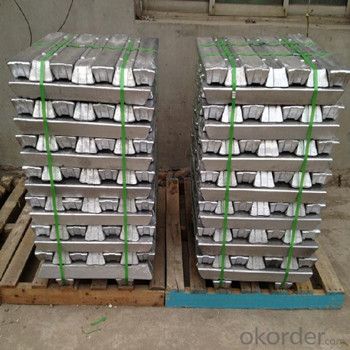
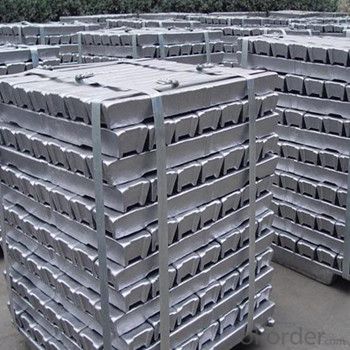
4.Aluminum Pig/Ingot Specification
Grade | Chemical Composition % | |||||||||
Al≥ | impurities ≤ | |||||||||
Si | Fe | Cu | Ga | Mg | Zn | Mn | others | Sum | ||
Al99.9 | 99.90 | 0.50 | 0.07 | 0.005 | 0.02 | 0.01 | 0.025 | - | 0.010 | 0.10 |
Al99.85 | 99.85 | 0.80 | 0.12 | 0.005 | 0.03 | 0.02 | 0.030 | - | 0.015 | 0.15 |
Al99.7 | 99.70 | 0.10 | 0.20 | 0.010 | 0.03 | 0.02 | 0.030 | - | 0.030 | 0.30 |
Al99.6 | 99.60 | 0.16 | 0.25 | 0.010 | 0.03 | 0.03 | 0.030 | - | 0.030 | 0.40 |
Al99.5 | 99.50 | 0.22 | 0.30 | 0.020 | 0.03 | 0.05 | 0.050 | - | 0.030 | 0.50 |
Al99.00 | 99.00 | 0.42 | 0.50 | 0.020 | 0.03 | 0.05 | 0.050 | - | 0.050 | 1.00 |
5.FAQ of Aluminum Pig/Ingot
We have organized several common questions for our clients,may help you sincerely:
①How about your company?
A professional manufacturers of the alumiun pig.Devoted in this industry for many years,so got much experice.The quality and service have also accepted by customer.Can meet customers' requiements to provide different grade and purity alumiun pig.
②How to guarantee the quality of the products?
We have established the international advanced quality management system,every link from raw material to final product we have strict quality test;We resolutely put an end to unqualified products flowing into the market. At the same time, we will provide necessary follow-up service assurance.
③How long can we receive the prod rking days, We will arrange the factory delivery as soon as possible. The pecific time of receiving is related to the state and position of customers.Commonly 7 to 10 working days can be served.
- Q: How are aluminum ingots used in the production of signage?
- The lightweight, durable, and versatile nature of aluminum ingots makes them crucial in the production of signage. When creating signage, aluminum ingots are melted and then turned into various sign components or sheets, depending on the desired design and purpose. One of the primary uses of aluminum ingots in signage production is for crafting sign frames. These frames provide structural support and stability to the signage, ensuring its longevity and resistance to weather conditions. Aluminum's lightweight nature makes it easier to transport, install, and maintain these sign frames. Furthermore, aluminum ingots are commonly utilized in creating sign panels or sheets. These panels can be cut, drilled, or shaped into different sizes and designs, allowing for customization and creativity in signage production. The durability of aluminum guarantees that these panels can endure outdoor exposure and remain intact for long periods. Moreover, aluminum ingots are employed in producing sign letters or logos. Signage made from aluminum letters provides a professional and sleek appearance that can enhance the overall aesthetic appeal of the signage. By using aluminum ingots, sign manufacturers can effortlessly create precise and intricate lettering. Additionally, aluminum ingots offer excellent corrosion resistance, making them ideal for outdoor signage applications. They can withstand harsh weather conditions, UV exposure, and temperature variations without deteriorating or losing their visual appeal. This makes aluminum an optimal material for outdoor signs where durability and longevity are crucial. In conclusion, the lightweight, durable, and versatile nature of aluminum ingots makes them widely used in signage production. They are transformed into sign frames, panels, and letters, providing structural support, customization options, and a professional appearance. With their corrosion resistance, aluminum ingots ensure that signage remains intact and visually appealing even in challenging outdoor environments.
- Q: Want to do a scrap processing of aluminum ingots of small workshops, about investment of about 100 thousand, the specific process, need what equipment technology, please expert advice
- Because it is profit, a ton of scrap, more of a water, is 160 dollars. The equipment is also very critical, when bad equipment in the melting scrap loss is large, so the water rate is down. Experienced and inexperienced, the difference in the rate of effluent can be 10 points. It is suggested that on-the-spot investigation should be conducted with prudent investment.
- Q: What are the properties of aluminum ingots that make them suitable for construction?
- Aluminum ingots possess several properties that make them suitable for construction purposes. Firstly, they have a high strength-to-weight ratio, which means they are lightweight yet strong enough to withstand the structural load. This makes them easier to handle and transport during construction projects. Secondly, aluminum ingots have excellent corrosion resistance, making them highly durable and suitable for outdoor applications. Additionally, aluminum is non-magnetic and non-sparking, making it safe to use in sensitive areas. Moreover, aluminum ingots can be easily formed and fabricated into various shapes, allowing for versatility in construction design. Lastly, aluminum is a sustainable material as it is fully recyclable, reducing environmental impact.
- Q: What are the different extrusion processes for aluminum ingots?
- There are several different extrusion processes for aluminum ingots, each with its own unique characteristics and applications. Some of the most commonly used extrusion processes for aluminum include: 1. Direct extrusion: This is the most common extrusion process for aluminum ingots. In this process, the ingot is heated and then forced through a die using a ram or a hydraulic press. The material flows in the same direction as the ram, resulting in a continuous profile with a consistent cross-section. 2. Indirect extrusion: In this process, the die is stationary and the ingot is forced through the die using a hollow ram. The material flows in the opposite direction of the ram, resulting in a profile with a higher surface finish and improved mechanical properties. 3. Impact extrusion: This process is used to create hollow shapes, such as tubes or containers, by striking a punch against the ingot. The force of the impact causes the metal to flow around the punch, forming the desired shape. Impact extrusion is often used for high-volume production of small parts. 4. Cold extrusion: Unlike the previous processes which involve heating the ingot, cold extrusion is performed at room temperature. The ingot is placed in a die and compressed using a hydraulic press or mechanical force. Cold extrusion is commonly used for producing complex shapes with tight tolerances and excellent surface finish. 5. Hydrostatic extrusion: This process involves placing the ingot in a sealed chamber filled with a liquid, typically oil or water. Pressure is applied to the liquid, which in turn applies even pressure on the ingot. Hydrostatic extrusion is often used for extruding alloys with low ductility or complex shapes. Each extrusion process has its advantages and limitations, and the choice depends on factors such as the desired product shape, material properties, production volume, and cost considerations.
- Q: What are the different alloying elements used in aluminum ingots?
- Aluminum ingots can be enhanced with various alloying elements to improve their properties and characteristics. Some commonly utilized alloying elements are: 1. Copper (Cu): To increase the strength and hardness of the alloy, copper is frequently added to aluminum ingots. Copper-aluminum alloys, also known as aluminum bronzes, exhibit outstanding corrosion resistance and find extensive usage in marine applications. 2. Zinc (Zn): Aluminum ingots often incorporate zinc as an alloying element to enhance the metal's castability. Aluminum-zinc alloys, like the 7000 series, possess high strength, good corrosion resistance, and are prevalent in aerospace and automotive applications. 3. Magnesium (Mg): Magnesium is a widely employed alloying element in aluminum ingots, especially in the 5000 series alloys. It improves aluminum's strength, machinability, and provides excellent corrosion resistance. Aluminum-magnesium alloys are commonly utilized in structural applications. 4. Silicon (Si): The addition of silicon to aluminum ingots improves their casting characteristics and reduces solidification shrinkage. Aluminum-silicon alloys, such as the 4000 series, exhibit good fluidity and are often employed in automotive and electronic components. 5. Manganese (Mn): Aluminum ingots can incorporate manganese as an alloying element to increase strength and improve corrosion resistance. Aluminum-manganese alloys, like the 3000 series, possess good formability and are commonly used in the construction and packaging industries. 6. Chromium (Cr): Aluminum ingots can be enriched with chromium to enhance their heat resistance and mechanical properties. Aluminum-chromium alloys, such as the 2000 series, are frequently employed in aerospace and high-temperature applications. 7. Lithium (Li): In small quantities, lithium, a lightweight and highly reactive element, is utilized to create aluminum-lithium alloys with high strength and low density. These alloys are primarily utilized in aerospace applications where weight reduction is crucial. These represent only a fraction of the alloying elements employed in aluminum ingots. The selection of alloying elements depends on the desired properties of the final product and its intended application.
- Q: How are aluminum ingots used in the production of window frames?
- Aluminum ingots are melted down and formed into extruded profiles, which are then cut and assembled to create window frames. The ingots provide the raw material necessary for the manufacturing process and ensure the frames are lightweight, durable, and corrosion-resistant.
- Q: How are aluminum ingots used in the production of architectural facades?
- Aluminum ingots play a crucial role in the production of architectural facades. These ingots are the primary raw material used to manufacture various aluminum products, including facades. To begin with, the ingots are melted and then cast into different shapes and forms, such as sheets or extrusions, depending on the design requirements of the facade. This casting process allows for customization and flexibility in creating architectural elements with different sizes, profiles, and finishes. Once the aluminum is transformed into its desired form, it undergoes further processing, such as cutting, bending, and machining, to achieve the specific design details required for the facade. This flexibility allows architects and designers to create intricate patterns, shapes, and textures, enhancing the overall aesthetic appeal of the building's exterior. Additionally, aluminum ingots possess excellent strength-to-weight ratio and corrosion resistance properties. These characteristics make aluminum an ideal choice for architectural facades as it can withstand harsh weather conditions, including heavy rain, strong winds, and extreme temperatures, without compromising its structural integrity. Moreover, aluminum facades are known for their durability and low maintenance requirements. The corrosion resistance of aluminum ensures that the facade can retain its original appearance for an extended period, reducing the need for frequent repairs or replacements. Furthermore, aluminum is a sustainable material as it can be recycled repeatedly without losing its quality. This recyclability aspect makes it an environmentally-friendly choice for architectural facades, aligning with the increasing focus on sustainable construction practices. In conclusion, aluminum ingots are essential in the production of architectural facades due to their versatility, strength, durability, and sustainability. The ability to mold aluminum into various shapes and forms allows for the creation of visually appealing and functional facades that withstand the test of time and contribute to sustainable building practices.
- Q: How to calculate the price with or without ticket in the aluminum ingot trade? Does the invoice price increase with aluminum?
- As to whether the invoice price fluctuates with the fluctuation of the aluminium ingot price, this is also the prior agreement between the seller and the buyer. Generally, the bulk of the sensitive price goods will be agreed on a floating price, that is, the price of the settlement, the market price of floating and floating.
- Q: What are the different heat treatment processes for aluminum ingots?
- Some of the different heat treatment processes for aluminum ingots include annealing, solution heat treatment, precipitation hardening, and quenching.
- Q: What are the scouring agents in the die casting process, such as slag remover, coating agent, flux, and what matters should be paid attention to when the aluminium ingot is dissolved?,
- Covering agentA layer of scum is formed on the surface of the liquid metal to avoid direct contact with airShould pay attention to in the melting alloy aluminum alloy ingots and scrap: when the proportion of its melting temperature control, the order of processing liquid aluminum. When smelting equipment drying and so on.
Send your message to us
Aluminum Pig/Ingot With Best Price From China
- Loading Port:
- China main port
- Payment Terms:
- TT OR LC
- Min Order Qty:
- 1000 m.t.
- Supply Capability:
- 100000 m.t./month
OKorder Service Pledge
OKorder Financial Service
Similar products
Hot products
Hot Searches
